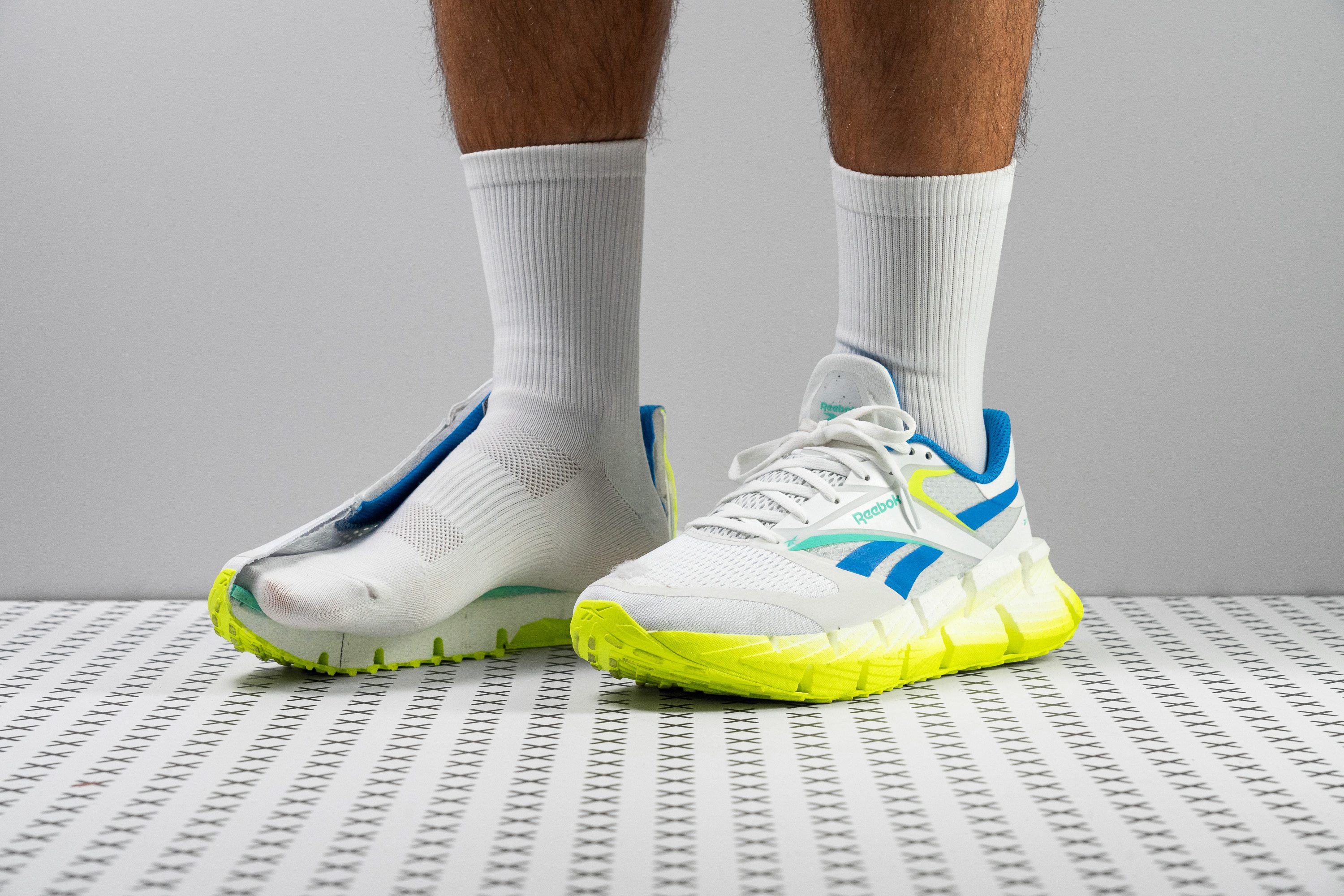Our verdict
- Top pick in best Reebok running shoes
Pros
- Unique retro-inspired design
- All-around reflectivity
- Higher stack than other daily trainers
- Doubles as a sneaker
- Durable TPE midsole
- Wide and stable heel
- Suitable for long runs
- Fairly priced
- Ortholite footbed
Cons
- Snug midfoot and tapered toebox
- On the heavier side
- Outsole durability
- Firm feel
Audience verdict
- Top 25% in road running shoes
- Top 25% in Reebok running shoes
Comparison
The most similar running shoes compared
+ + Add a shoe | |||||
|---|---|---|---|---|---|
| Audience score | 89 Great! | 92 Superb! | 80 Good! | 89 Great! | |
| Price | $130 | $140 | $120 | $180 | |
| Pace | Daily running | Daily runningTempo | Daily runningTempo | Daily running | |
| Shock absorption | Moderate | High | High | High | |
| Energy return | Moderate | Moderate | Moderate | Moderate | |
| Traction | Moderate | High | Moderate | High | |
| Arch support | Neutral | Neutral | Neutral | Neutral | |
| Weight lab Weight brand | 10.1 oz / 285g 9.8 oz / 277g | 9 oz / 254g 9 oz / 255g | 9.5 oz / 269g 9.7 oz / 275g | 10.3 oz / 292g 10.4 oz / 295g | |
| Drop lab Drop brand | 7.0 mm 6.0 mm | 7.4 mm 8.0 mm | 6.7 mm 6.0 mm | 6.6 mm 6.0 mm | |
| Strike pattern | HeelMid/forefoot | Mid/forefoot | Mid/forefoot | Mid/forefoot | |
| Size | True to size | True to size | Slightly small | Slightly large | |
| Midsole softness | Balanced | Soft | Soft | Balanced | |
| Difference in midsole softness in cold | Normal | Big | Normal | Small | |
| Toebox durability | Decent | Bad | Bad | Good | |
| Heel padding durability | Decent | Decent | Bad | Decent | |
| Outsole durability | Bad | Good | Decent | Good | |
| Breathability | Moderate | Moderate | Breathable | Warm | |
| Width / fit | Medium | Medium | Medium | Wide | |
| Toebox width | Medium | Medium | Medium | Medium | |
| Stiffness | Moderate | Moderate | Moderate | Stiff | |
| Torsional rigidity | Moderate | Stiff | Moderate | Moderate | |
| Heel counter stiffness | Moderate | Moderate | Moderate | Moderate | |
| Rocker | ✓ | ✓ | ✗ | ✓ | |
| Heel lab Heel brand | 36.8 mm 31.0 mm | 40.9 mm 41.5 mm | 35.2 mm 37.0 mm | 37.9 mm 35.0 mm | |
| Forefoot lab Forefoot brand | 29.8 mm 25.0 mm | 33.5 mm 33.5 mm | 28.5 mm 31.0 mm | 31.3 mm 29.0 mm | |
| Widths available | Normal | NormalWide | NormalWide | Normal | |
| Orthotic friendly | ✓ | ✓ | ✓ | ✓ | |
| Season | All seasons | All seasons | SummerAll seasons | All seasons | |
| Removable insole | ✓ | ✓ | ✓ | ✓ | |
| Ranking | #86 Top 24% | #19 Top 6% | #304 Bottom 18% | #98 Top 27% | |
| Popularity | #256 Bottom 31% | #7 Top 2% | #190 Bottom 49% | #36 Top 10% |
Who should buy
We highly recommend the FloatZig 1 for those seeking a unique blend of modern technology with a retro twist. In our view, it's:
- Ideal for nostalgic runners who demand contemporary comfort—this shoe combines advanced cushioning with classic aesthetics.
- Perfect for those desiring to stand out with a distinctive, bold design far from mainstream choices.
- Exceptional for night runners, thanks to its abundant reflective details, enhancing visibility and safety.
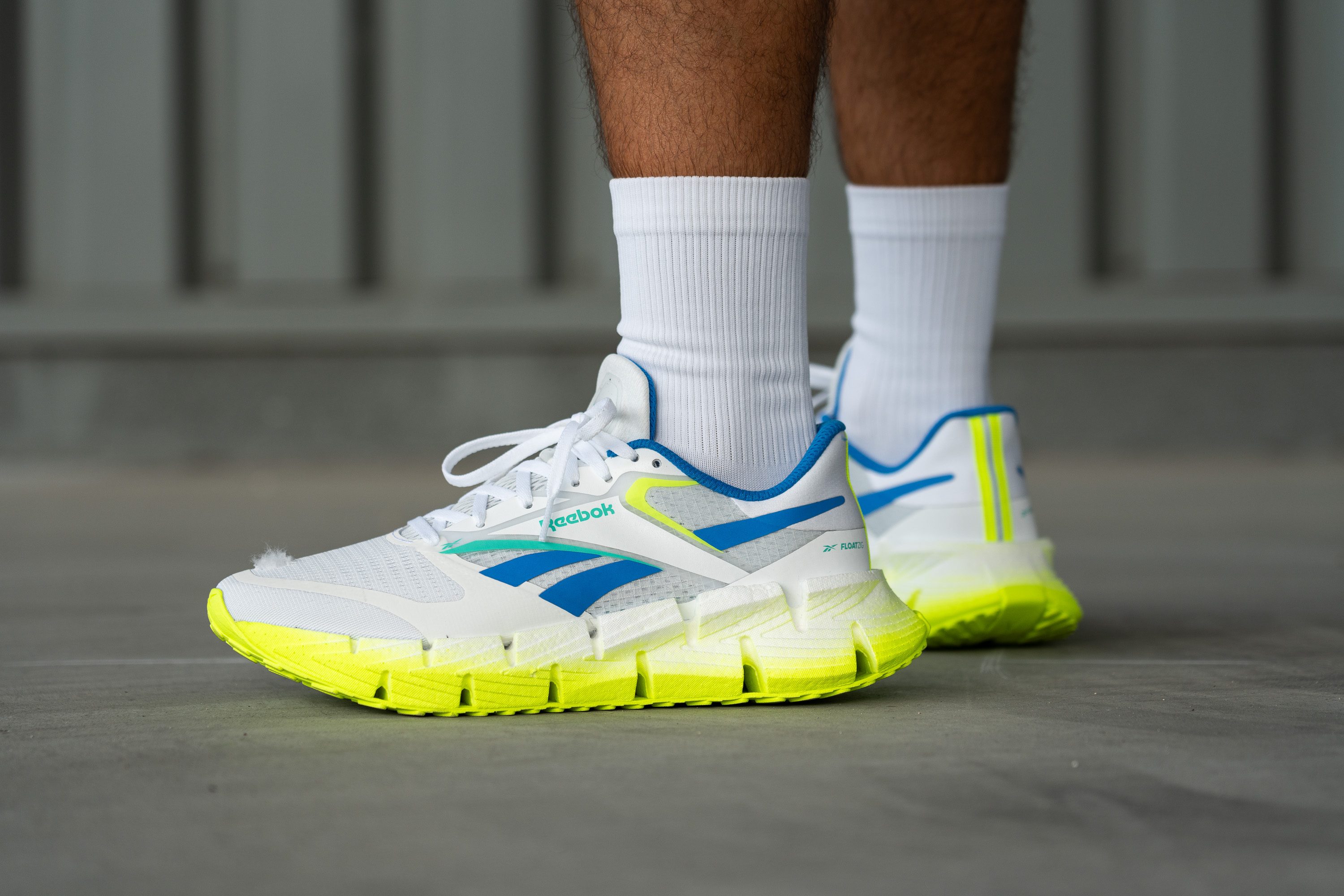
Who should NOT buy
We think the FloatZig 1 may underwhelm those preferring a higher drop in their daily trainers, as its 7-mm offset sits lower than many classic high-drop options. For runners prioritizing a more pronounced offset, best-sellers like the Brooks Ghost 16 or Adidas Supernova Rise provide a more traditional feel and come at comparable prices.
Additionally, we believe the FloatZig 1’s weight could be a drawback for runners seeking a lightweight, responsive trainer. It’s a bit heavier than some competitors, making the ASICS Novablast 4, Nike Pegasus Plus, or Hoka Mach 6 better choices for runners wanting a lightweight workhorse.

Cushioning
Shock absorption
There’s no denying the FloatZig 1 looks massive from the side—and the lab numbers back it up. We recorded 130 SA in the heel and 113 SA in the forefoot, making it a solid choice for everything from short efforts to long runs.
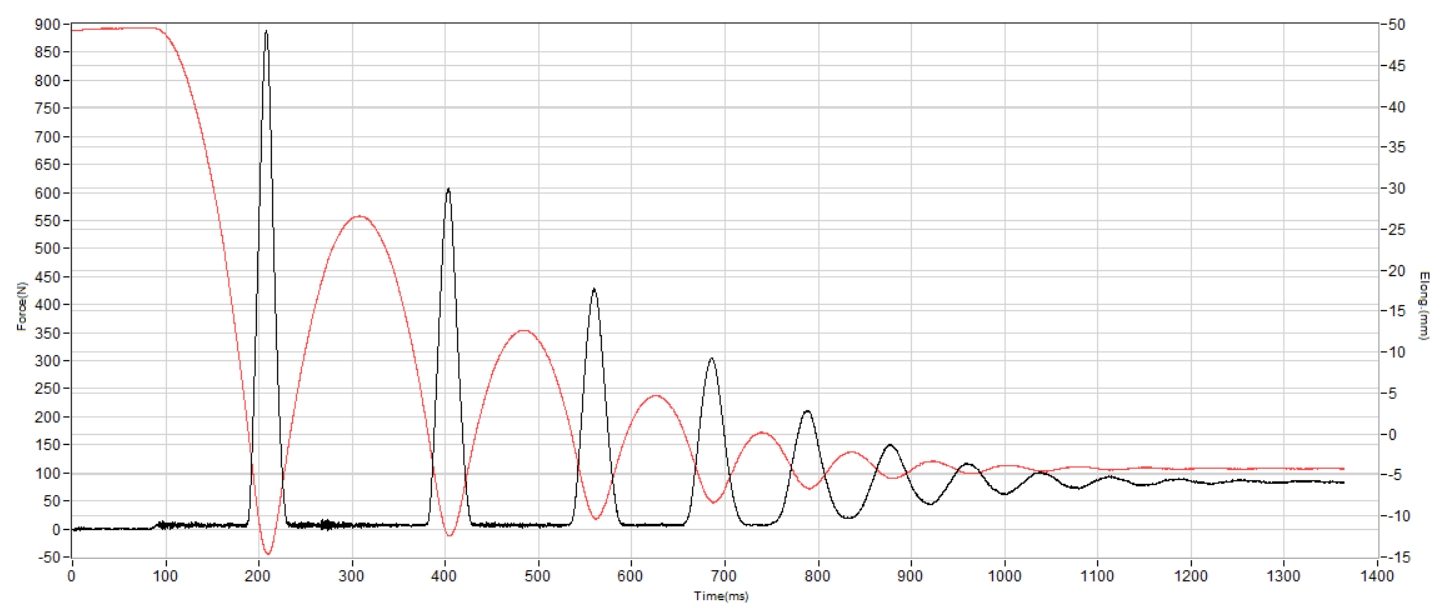
| FloatZig 1 | 130 SA |
| Average | 129 SA |
Energy return
Energy return is perfectly acceptable at 59.6%. It may not top our charts, but we’ve tested plenty of daily trainers that cost more and deliver far less bounce underfoot.
| FloatZig 1 | 59.6% |
| Average | 58.5% |
Heel stack
With a substantial 36.8 mm heel stack, the FloatZig 1 delivers impressive cushioning. This height even exceeds many daily trainers, offering a versatile option for runners seeking extra heel protection for their muscles and joints.

| FloatZig 1 | 36.8 mm |
| Average | 34.8 mm |
Forefoot stack
The forefoot was a surprise. Measuring 29.8 mm, it nearly hits the 30-mm mark—putting the FloatZig 1 among the thickest shoes in its class.
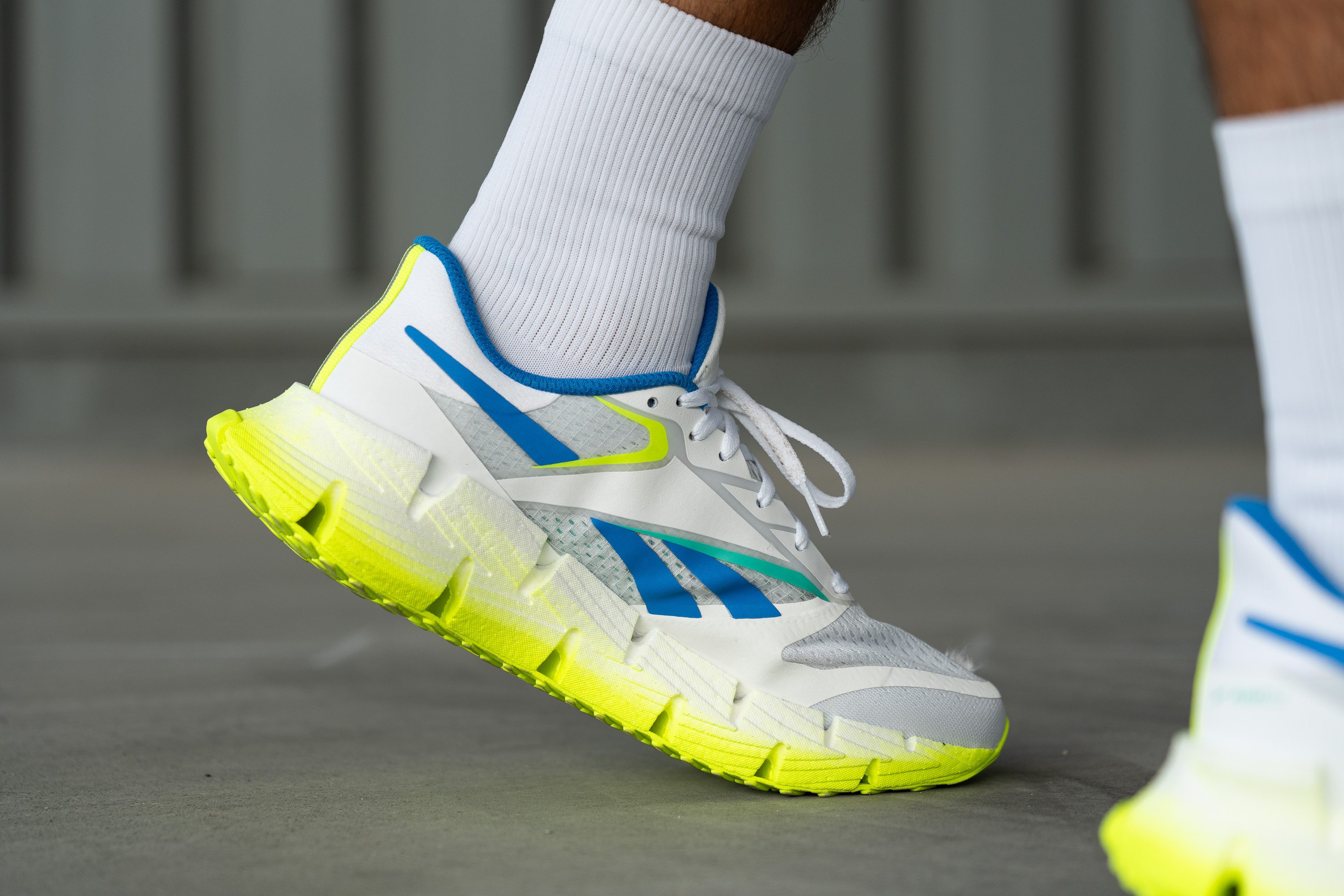
This substantial stack height is well above average, positioning the FZ1 as a versatile option with generous underfoot protection. We think it’s especially beneficial for long runs, where other daily trainers—often below 25 mm in this area—can't offer the same level of cushioning.
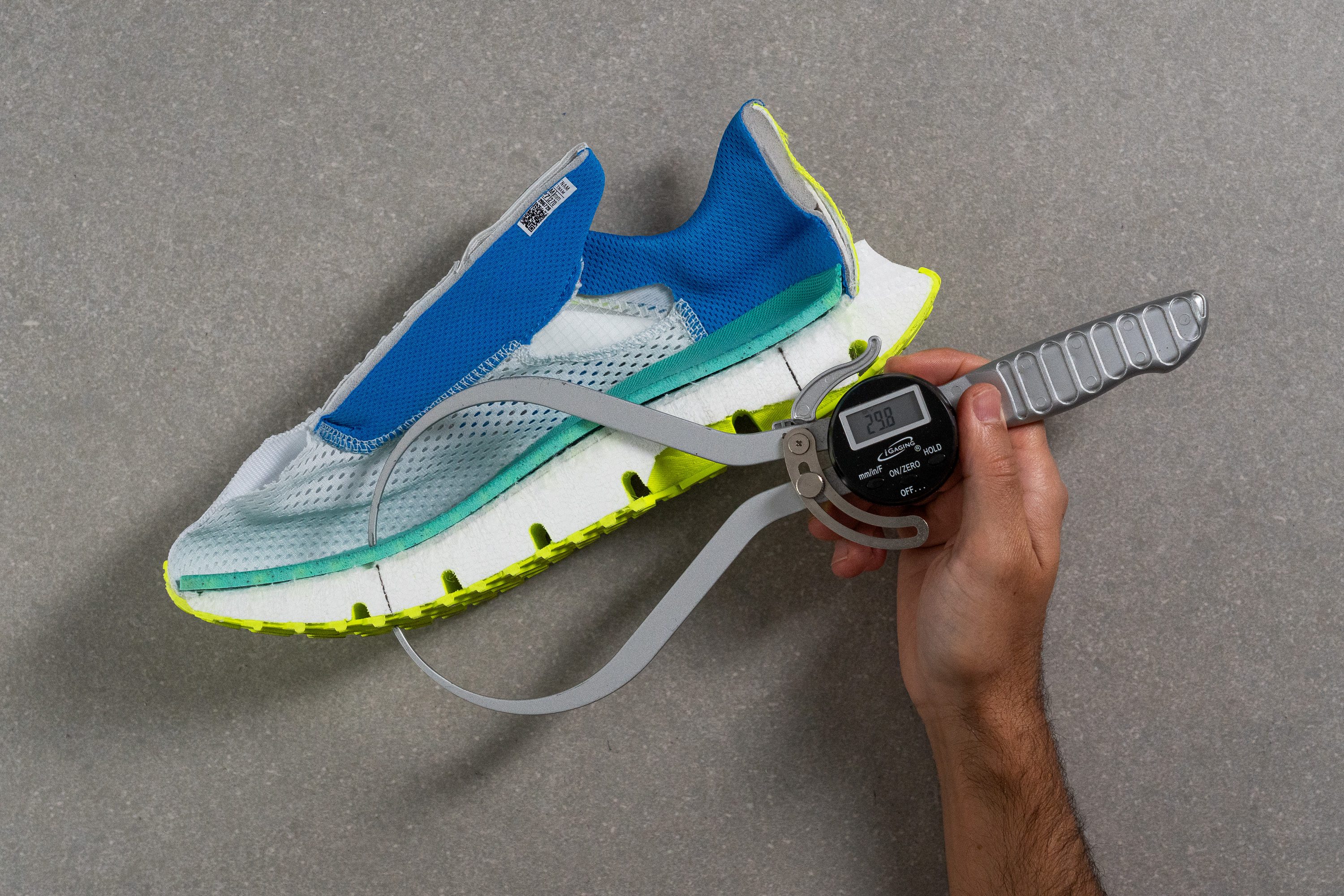
| FloatZig 1 | 29.8 mm |
| Average | 26.2 mm |
Drop
This is also a nice option for runners who prefer a medium-drop shoe, offering a 7-mm offset—an interesting shift from the usual 8-to-12-mm range often seen in this category.
But is this a dealbreaker? We don’t believe so. Moving from 7 to 8 or even 10 mm is hardly noticeable but may slightly enhance its appeal to forefoot and midfoot strikers.

| FloatZig 1 | 7.0 mm |
| Average | 8.6 mm |
Midsole softness
One of the standout features of this shoe is its midsole. Unlike most daily trainers crafted from EVA, Reebok has opted for Floatride Energy—a TPE-based foam that’s noticeably more resilient and durable.
Is it super plush? Not exactly. With a moderate softness at 22.5 HA, the shoe feels firmer while running, likely due to the thick outsole that mutes some of the plushness. However, we found its energy return respectable, especially given the attractive price point.
Also notable is the "Zig" shape of the midsole, designed to reduce weight and add a touch of softness—similar to On’s approach with CloudTec technology in models like the Cloudmonster 2.
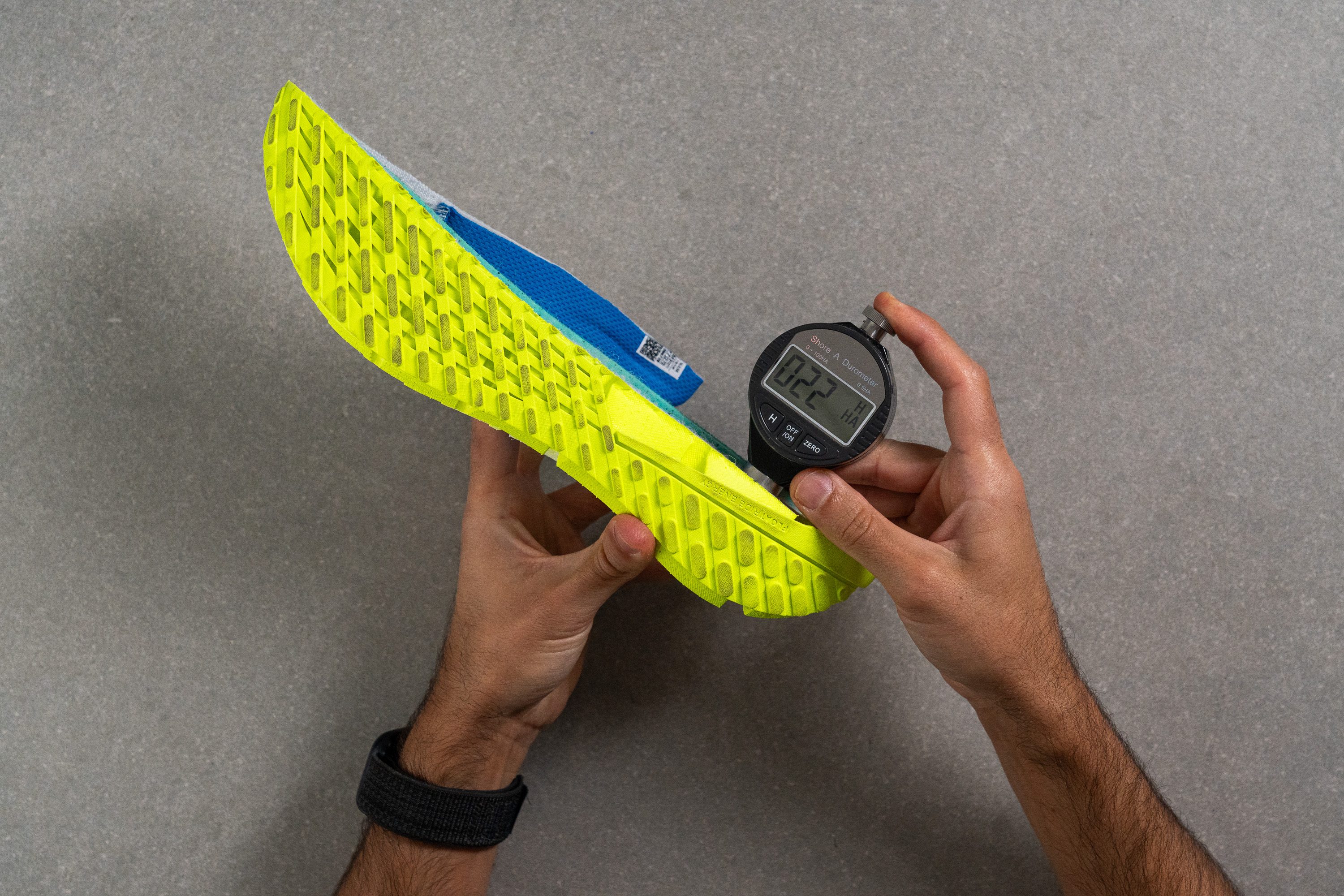
| FloatZig 1 | 22.5 HA |
| Average | 20.4 HA |
Rocker
While the FloatZig 1 embraces a retro-inspired aesthetic, its curved midsole brings a modern shape not seen in shoes from 20 or 30 years ago, with a prominent heel bevel that encourages early contact in this area, and a notable forefoot rocker.
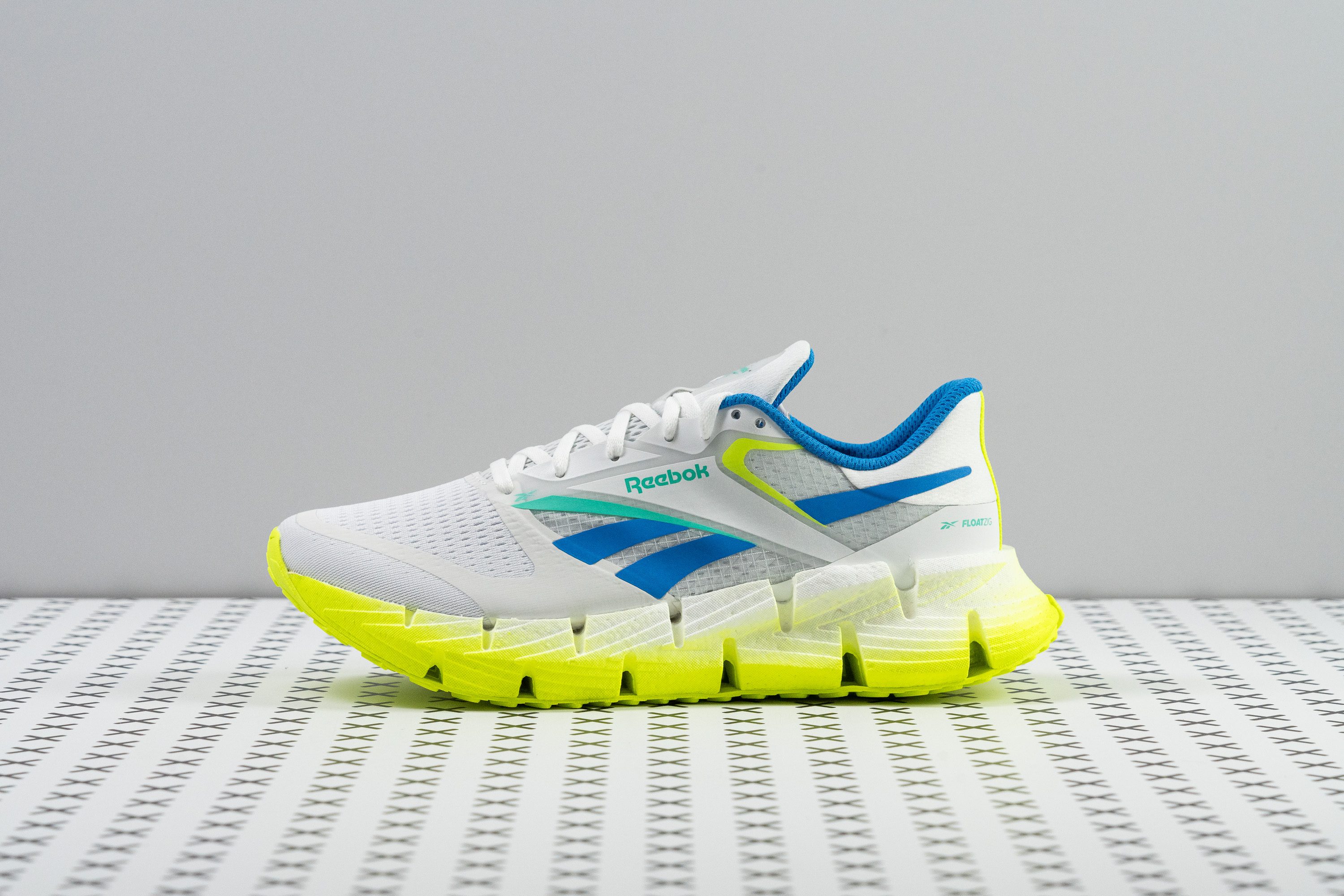
As shown below, the forefoot rocker is steep for a daily trainer, beginning late and angling sharply up to 5 cm. This design is a welcome feature for those with limited big toe mobility!
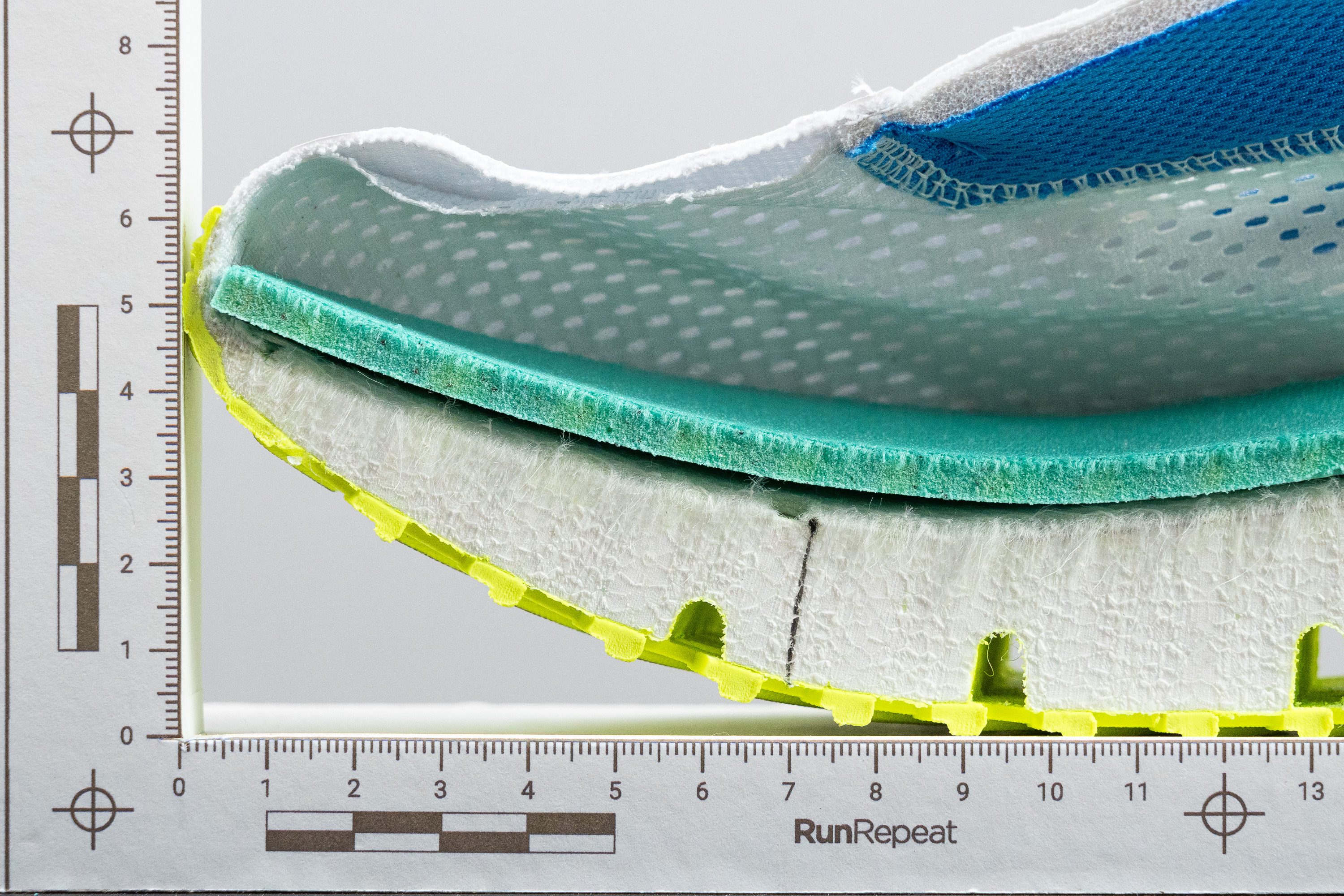
Size and fit
Size
Reebok FloatZig 1 fits true to size (44 votes).
Width / Fit
The step-in feel of the FloatZig 1 may not fully rival the plush comfort of top brands like Brooks, but it’s still quite satisfying.
Since this one is designed for daily miles rather than peak performance, finding 97.4 mm in the widest part of the shoe was a positive feature for us. Conversely, the midfoot area felt a bit tight.
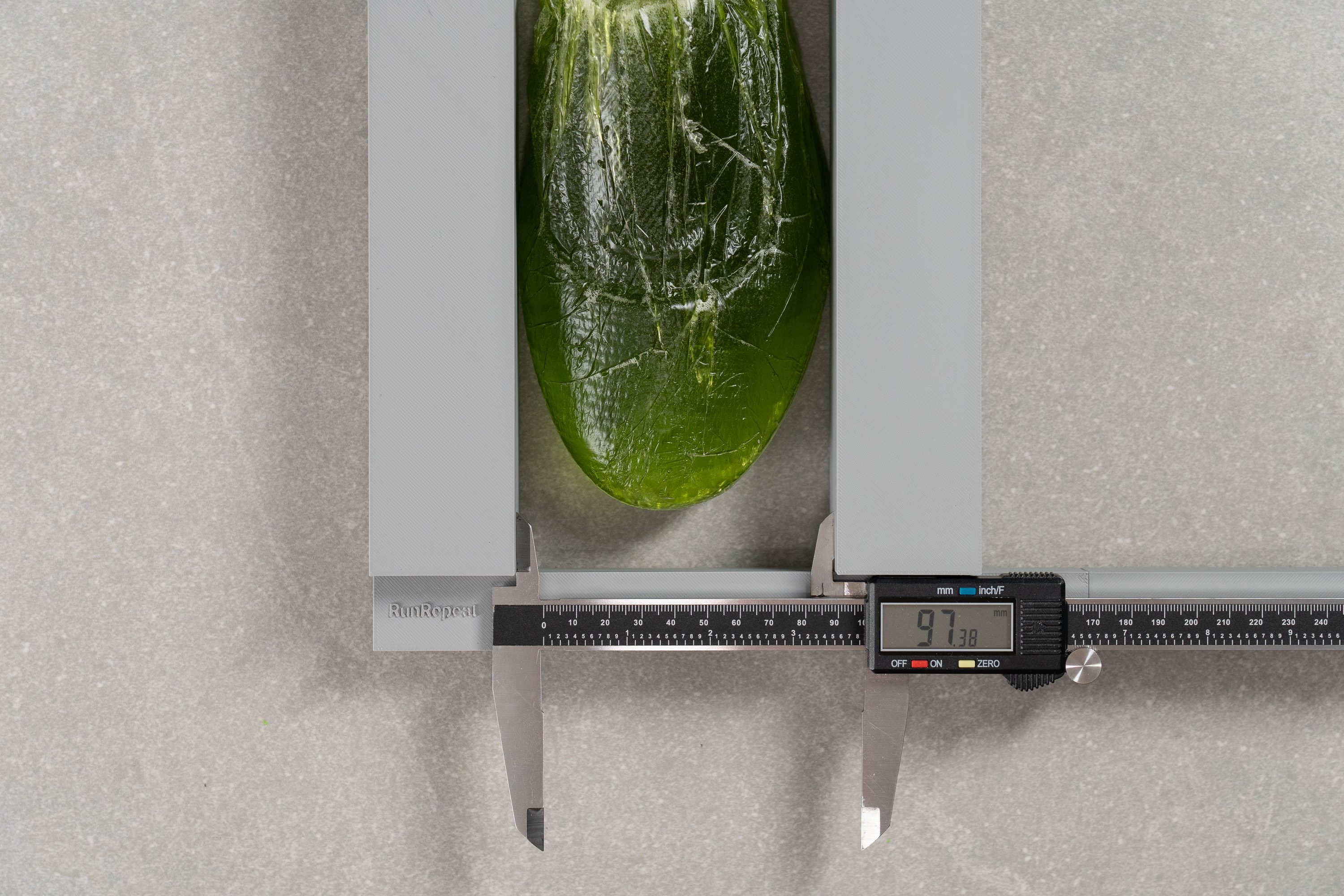
| FloatZig 1 | 97.4 mm |
| Average | 95.1 mm |
Toebox width
The first measurement stood comfortably above average, but the second tells a different story.
A pointy toebox might enhance the sleek, aesthetic appeal of any shoe, yet it compromises comfort for many runners. With just 71.2 mm in the big toe area, we believe this shoe is better suited for individuals with narrow feet.
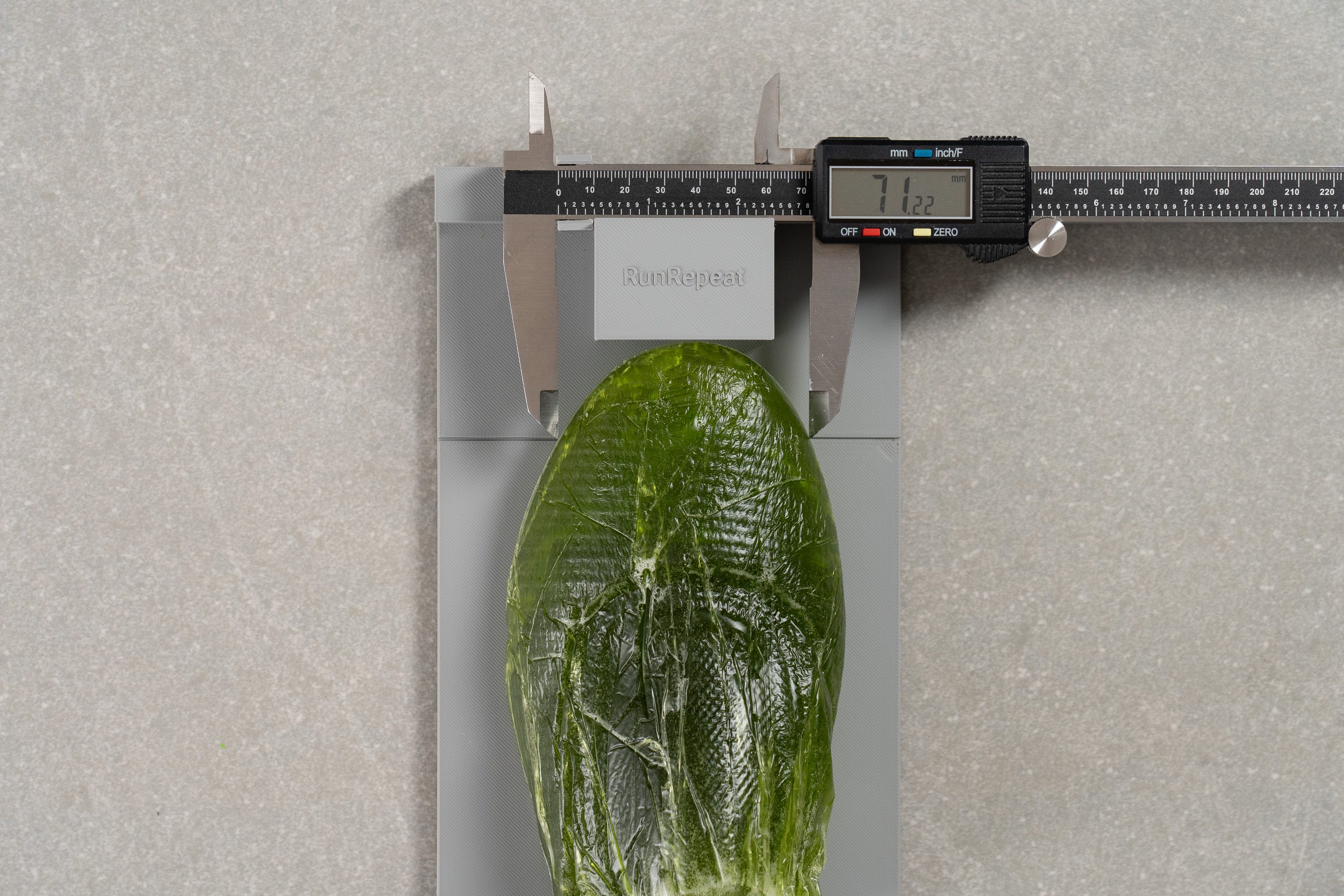
| FloatZig 1 | 71.2 mm |
| Average | 73.3 mm |
Toebox height
The toebox height also caught us off guard with its notably low measurement. While some runners might appreciate the snug fit, having just 23.7 mm of vertical space could pose challenges for comfort during daily miles.
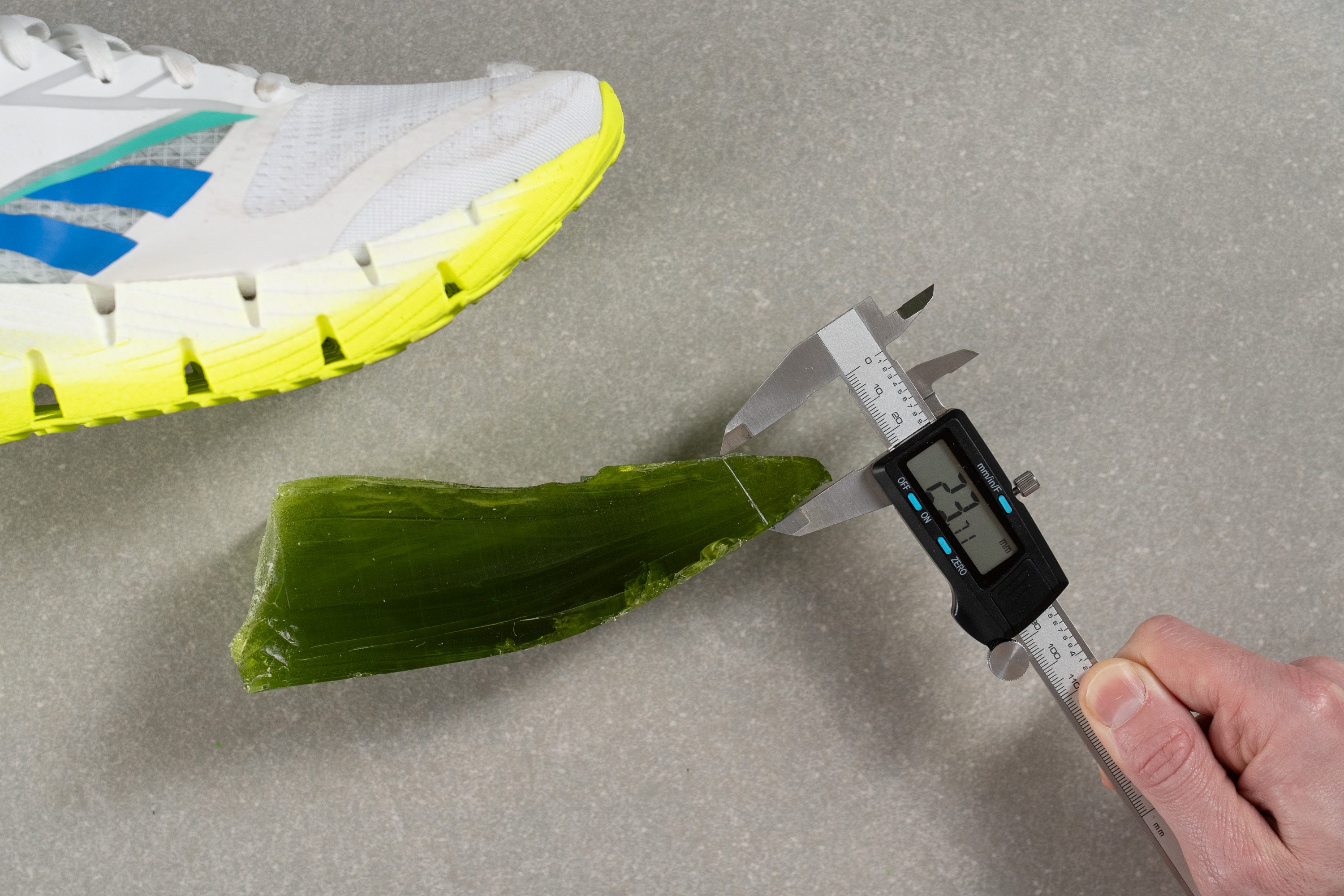
| FloatZig 1 | 23.7 mm |
| Average | 27.1 mm |
Traction / Grip
Traction test
Don’t let the 0.39 score mislead you. Even if it falls slightly below our current average, we found it more than capable for a daily trainer—offering confident, rain-ready grip and steady traction for those sunshine-filled Sunday long runs.
| FloatZig 1 | 0.39 |
| Average | 0.48 |
Outsole design
The FloatZig 1 features a full-coverage rubber outsole that blends almost seamlessly into the foam midsole due to their identical neon-yellow color—making it tricky to visually separate both components. A central groove spans the midfoot, while angled tread lines in the forefoot and heel enhance flex and reduce weight.
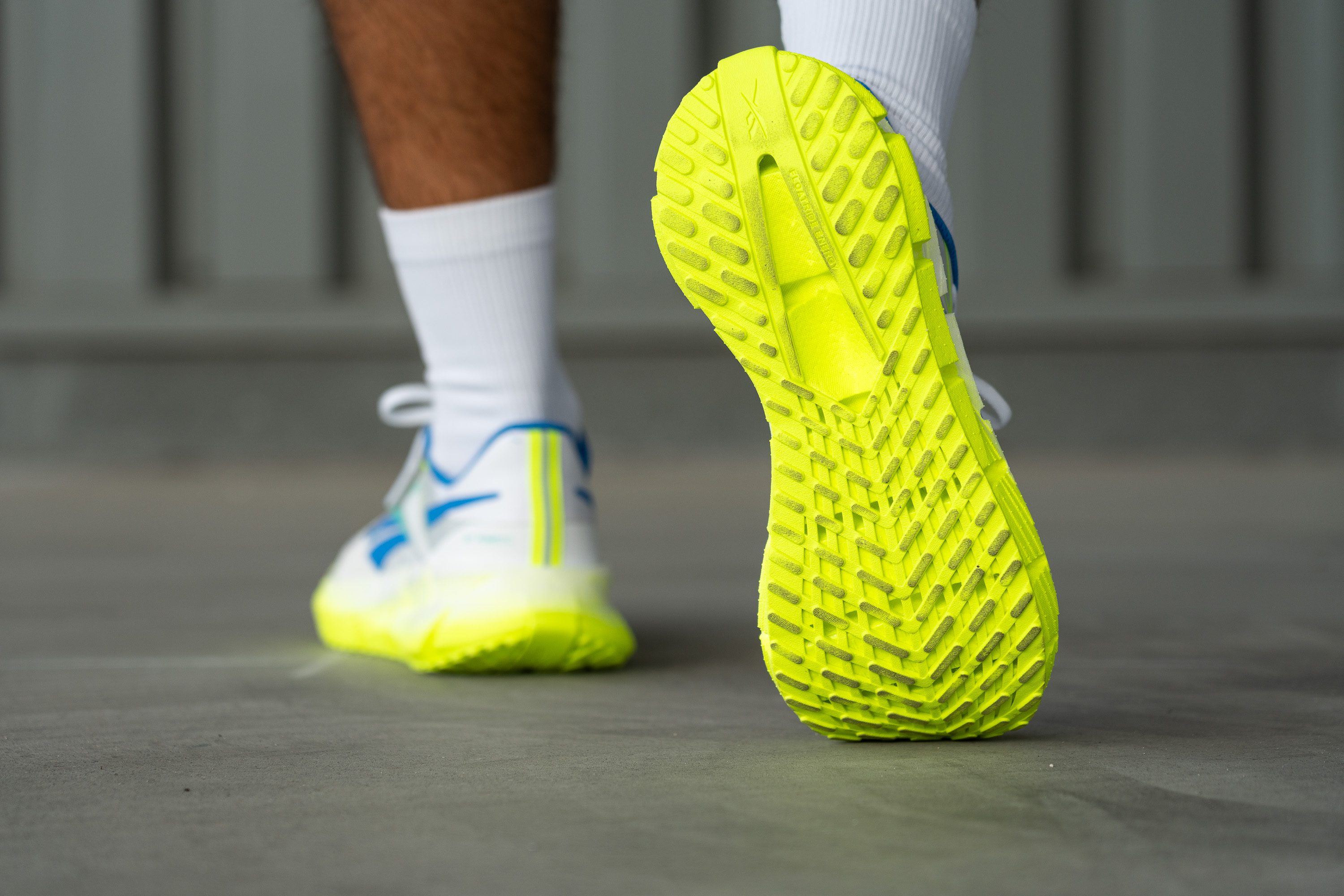
Flexibility / Stiffness
The stiffness test is essential for a retro-inspired shoe like the FloatZig 1, as a rigid build could undermine its comfort for casual wear.
But we were pleased with our findings as our force gauge recorded only 14.0N! This result confirms the shoe is ideal for everyday runs and versatile enough for daily activities or being a reliable travel companion.

| FloatZig 1 | 14.0N |
| Average | 15.3N |
Weight
Initially, we thought the FloatZig 1 felt a bit heavy for a daily trainer, especially with many brands making strides in reducing weight. But when we considered its generous underfoot foam and multi-layered upper—crafted for added comfort and durability—the 10.05 oz (285g) didn’t seem so bad.
Yet, in our view, Reebok could still benefit from shaving off about 10% to 15% of the weight in their next version, creating an even more agile yet cushion-packed shoe for daily use.
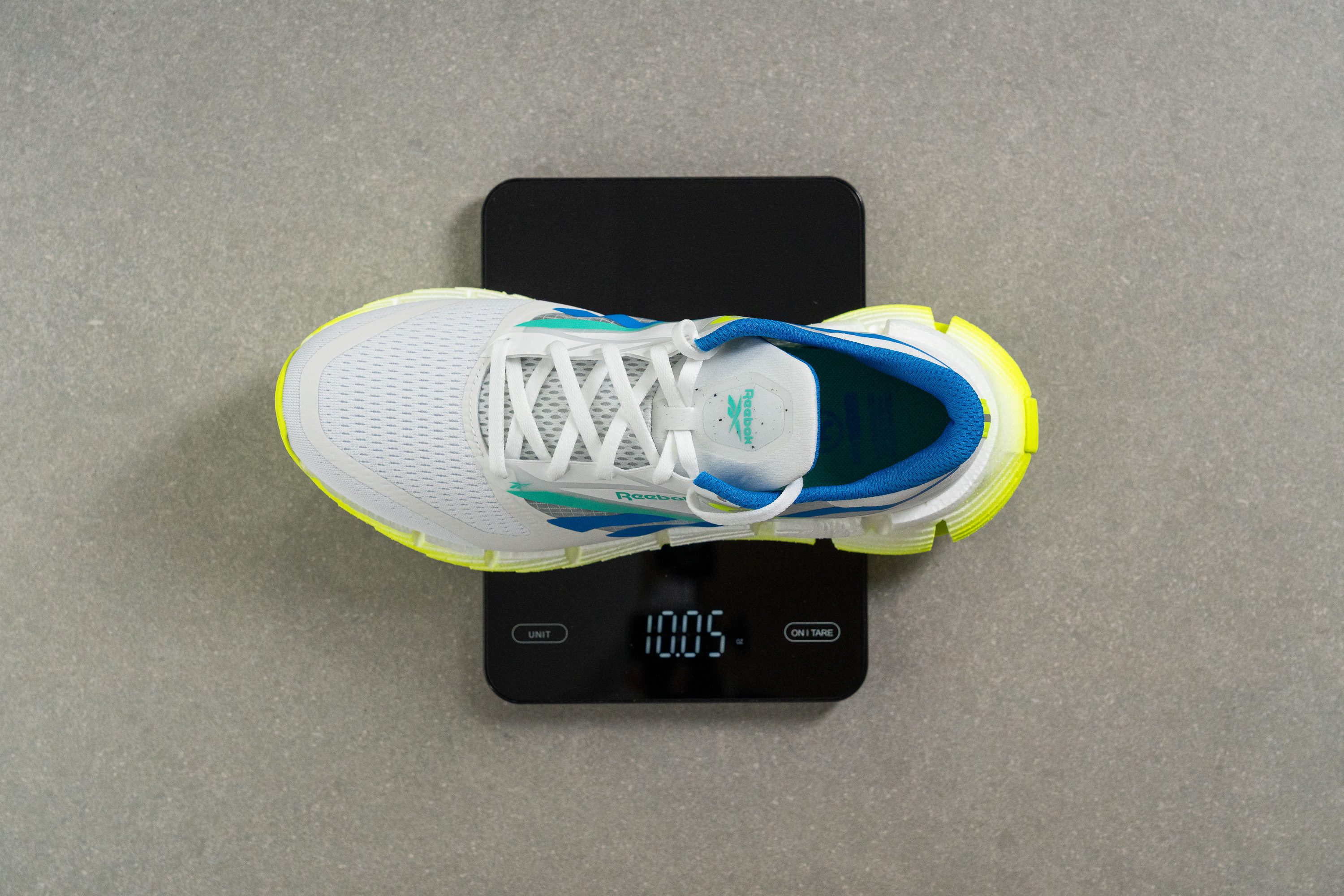
| FloatZig 1 | 10.1 oz (285g) |
| Average | 9.3 oz (264g) |
Breathability
We tested the FloatZig 1’s breathability using our smoke-pumping machine and were surprised to find that airflow wasn’t as limited as it seemed at first sight. Despite its dense upper, the shoe scored a respectable 3/5 on ventilation, showing it’s capable of providing some airflow.
To pinpoint the most ventilated zones, we used an LED light and found that Reebok strategically focused on the toebox and midfoot areas. This targeted approach allows the shoe to channel airflow where it’s needed most, even if the rest of the shoe is less ventilated.
In our microscope analysis, we observed that the upper is composed of two or maybe even three distinct layers.
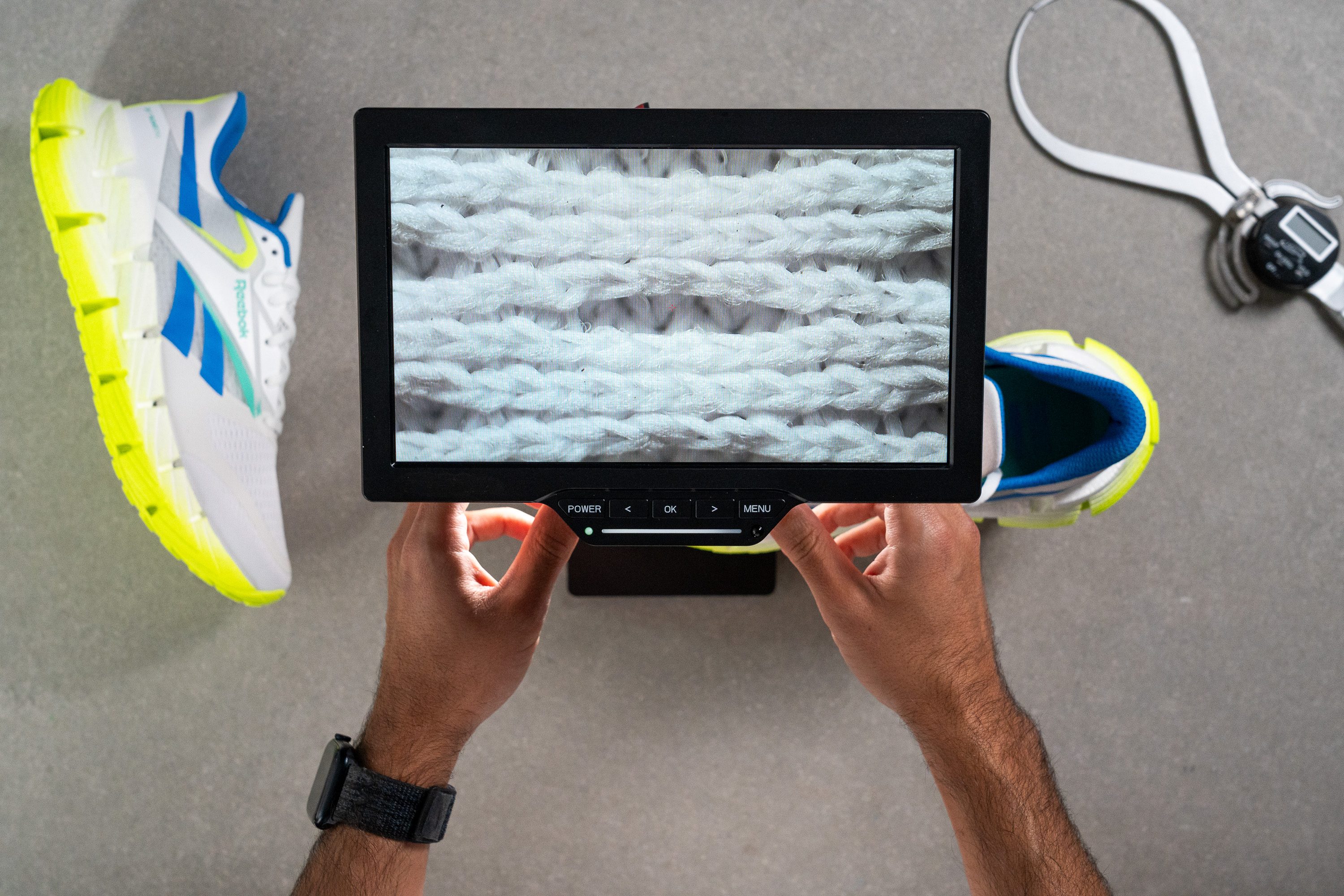
This setup allows for better airflow, creating a more comfortable experience than expected given the substantial thickness of the upper. Unlike typical models that use one or two layers, we confirmed that Reebok chose a triple-layer engineered mesh, balancing durability and airflow.
We’re also happy that the FloatZig 1 supports Reebok’s [REE]CYCLED initiative, using recycled materials to enhance sustainability without compromising comfort or durability.
| FloatZig 1 | 3 |
| Average | 3.7 |
Stability
Lateral stability test
Holding the FloatZig 1 in our hands, it didn’t feel like it would be especially stable, but it turned out to be surprisingly so. This stability comes from a mix of factors, with the generous sole flare—where the midsole extends outward to create a broader landing base—and the substantial heel being the key contributors.
Torsional rigidity
In our experience, there’s minimal impact on stability from torsional rigidity on this shoe, as we found a standard 3/5 score—consistent with what we typically see when testing daily trainers.
It’s interesting to see how Reebok’s “Zig” design impacts flexibility—without those cutouts, the shoe would definitely feel much more rigid!
| FloatZig 1 | 3 |
| Average | 3.5 |
Heel counter stiffness
The heel counter is also just average, scoring a standard 3/5. We believe Reebok played it safe here, aiming for a balanced feel to suit most runners—nothing out-of-the-ordinary to report, so we’re moving on!
| FloatZig 1 | 3 |
| Average | 2.9 |
Midsole width - forefoot
One approach to boost stability lies in the shoe’s dimensions. And the FloatZig 1 definitely has a wider-than-usual landing base, also known as sole flare.
In the forefoot, we measured 117.0 mm—just a bit wider than the average daily trainer, but not so wide that it alone accounts for the stable feel we experienced while running. Now, let’s examine the heel.
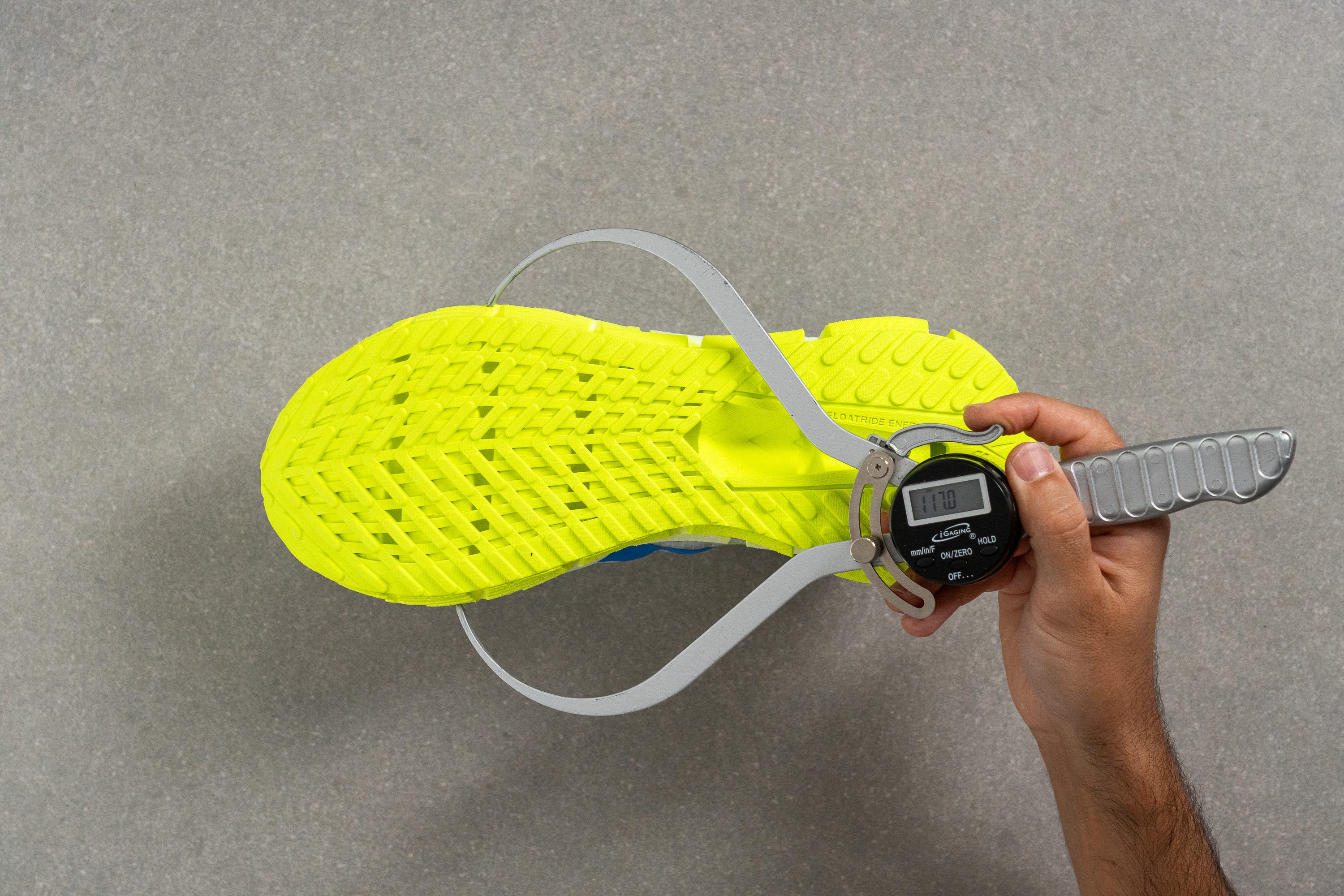
| FloatZig 1 | 117.0 mm |
| Average | 114.4 mm |
Midsole width - heel
We were genuinely surprised by the heel's impressive width—measuring 103.6 mm, it’s wider than nearly any other running shoe we've tested.
This expansive heel is even broader than many stability shoes, making it a solid option for rearfoot strikers seeking extra support without the overly rigid feel.
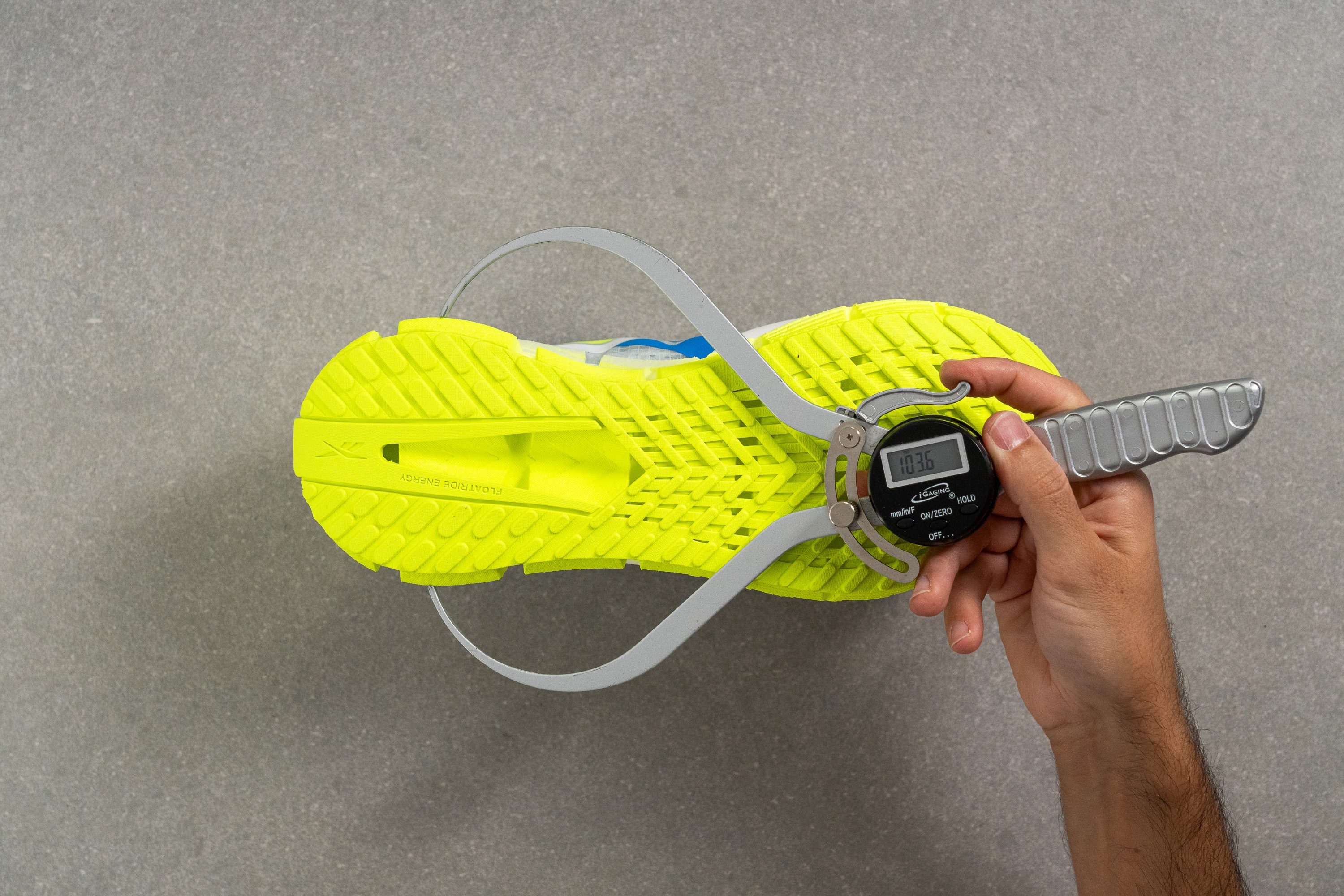
| FloatZig 1 | 103.6 mm |
| Average | 90.7 mm |
Durability
Toebox durability
An advantage of engineered mesh uppers with multiple layers is the natural boost in durability—exactly what we observed with the FloatZig 1.
When examining the hole, it was clear that if this shoe had been made from a single-layer monomesh, durability would have scored a mere 1/5 rather than a solid 3 out of 5.

| FloatZig 1 | 3 |
| Average | 2.6 |
Heel padding durability
The heel padding didn’t perform quite as well as the toebox, which wasn’t the best news.
In our experience, while most runners won’t have issues here, those prone to wearing holes in the heel area should note the FloatZig 1’s somewhat fragile heel collar.
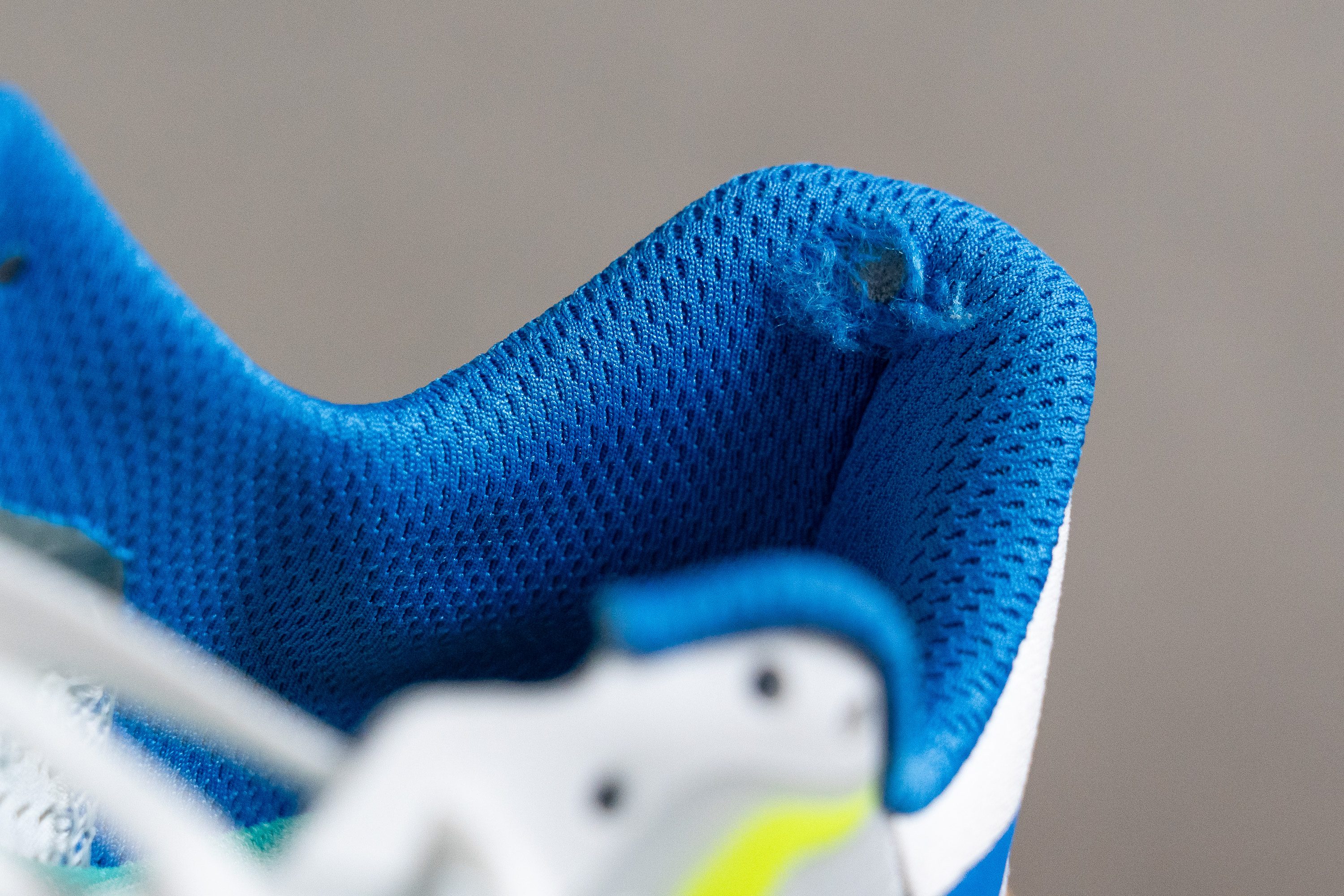
| FloatZig 1 | 2 |
| Average | 3.4 |
Outsole durability
In our third and final Dremel test, we pushed the tool up to 10K revs to put the outsole rubber to the ultimate test. We found the results slightly below our expectations, even considering that mini-lug outsoles generally struggle on this challenge.
The test revealed a 2.0-mm dent, which, while not ideal, suggests it should hold up for a decent lifespan due to the ample rubber below the lugs. But for those with uneven wear patterns, a more durable option like the Brooks Glycerin 21 might be a wiser choice.

| FloatZig 1 | 2.0 mm |
| Average | 1.1 mm |
Outsole thickness
We measured a thickness of 4.1 mm, which might seem excessive for most shoes but aligns well with the previous outcome.
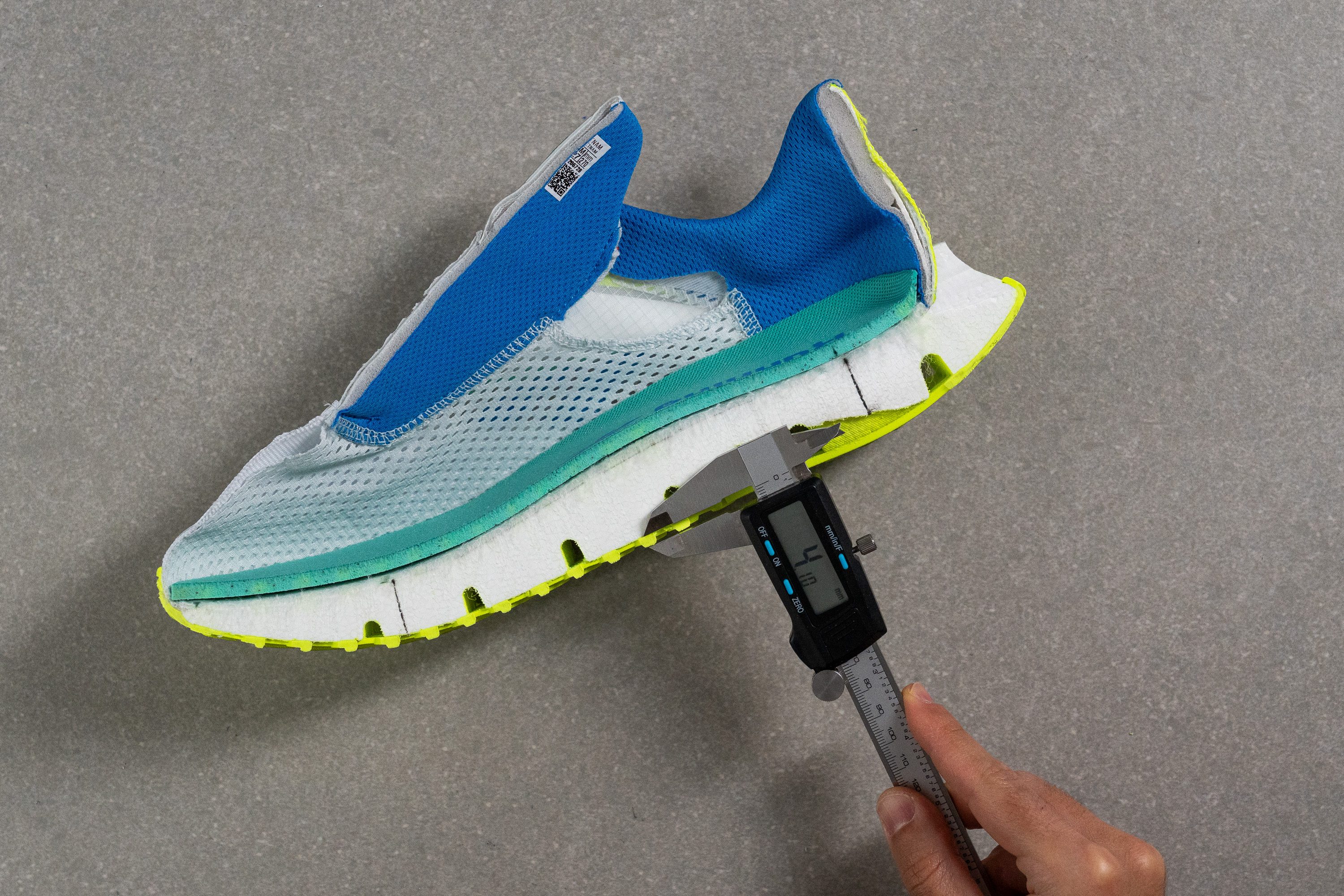
| FloatZig 1 | 4.1 mm |
| Average | 3.2 mm |
Misc
Insole thickness
We measured the insole of the FloatZig 1 and found it has a thickness of 4.4 mm—right around average! It’s also partially crafted from recycled materials, which we think is a great added bonus.
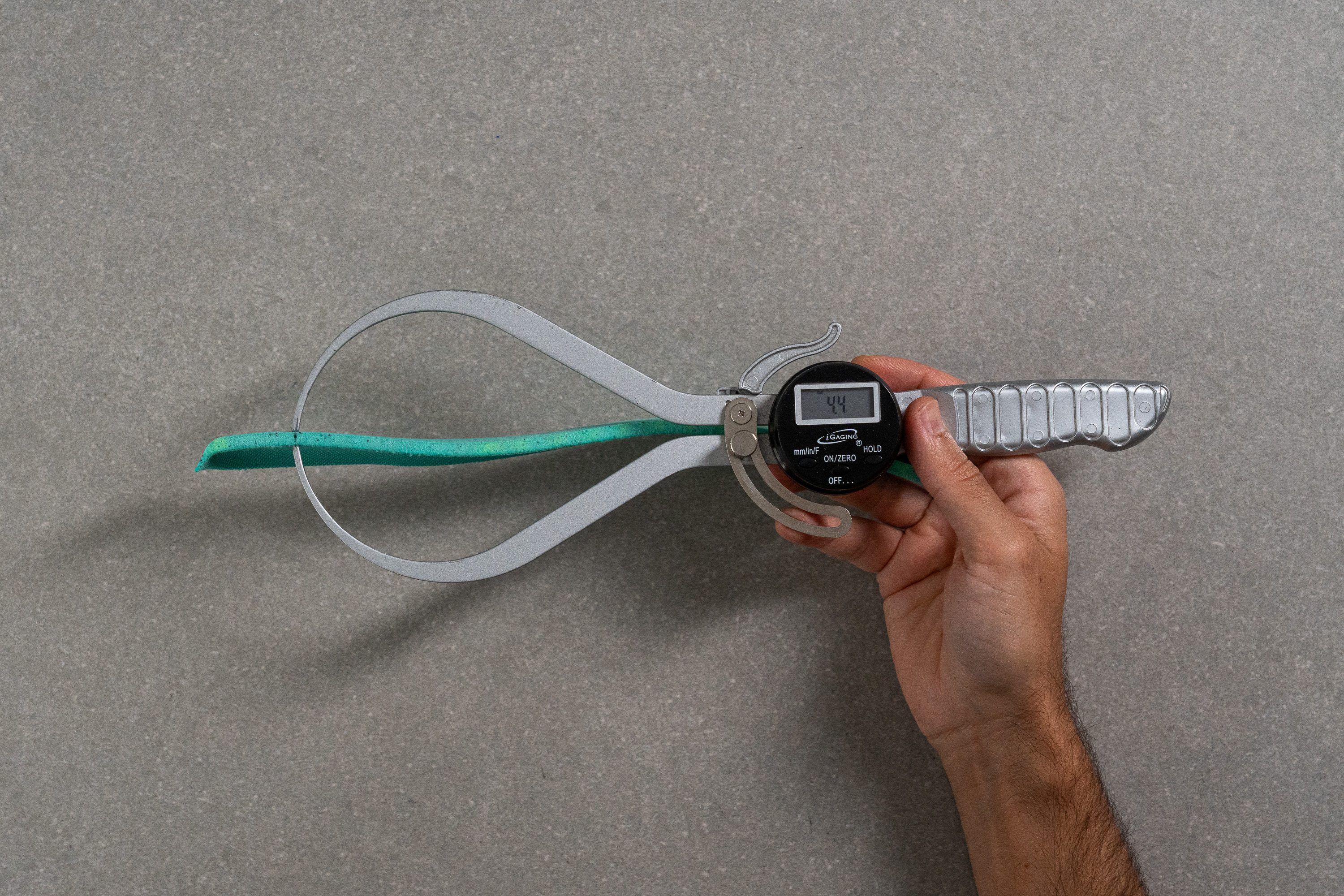
| FloatZig 1 | 4.4 mm |
| Average | 4.5 mm |
Removable insole
The Ortholite insole is removable, but swapping it means losing the arch's noticeable support-enhancing curve, so it might not be the best idea unless you're using a similar one.
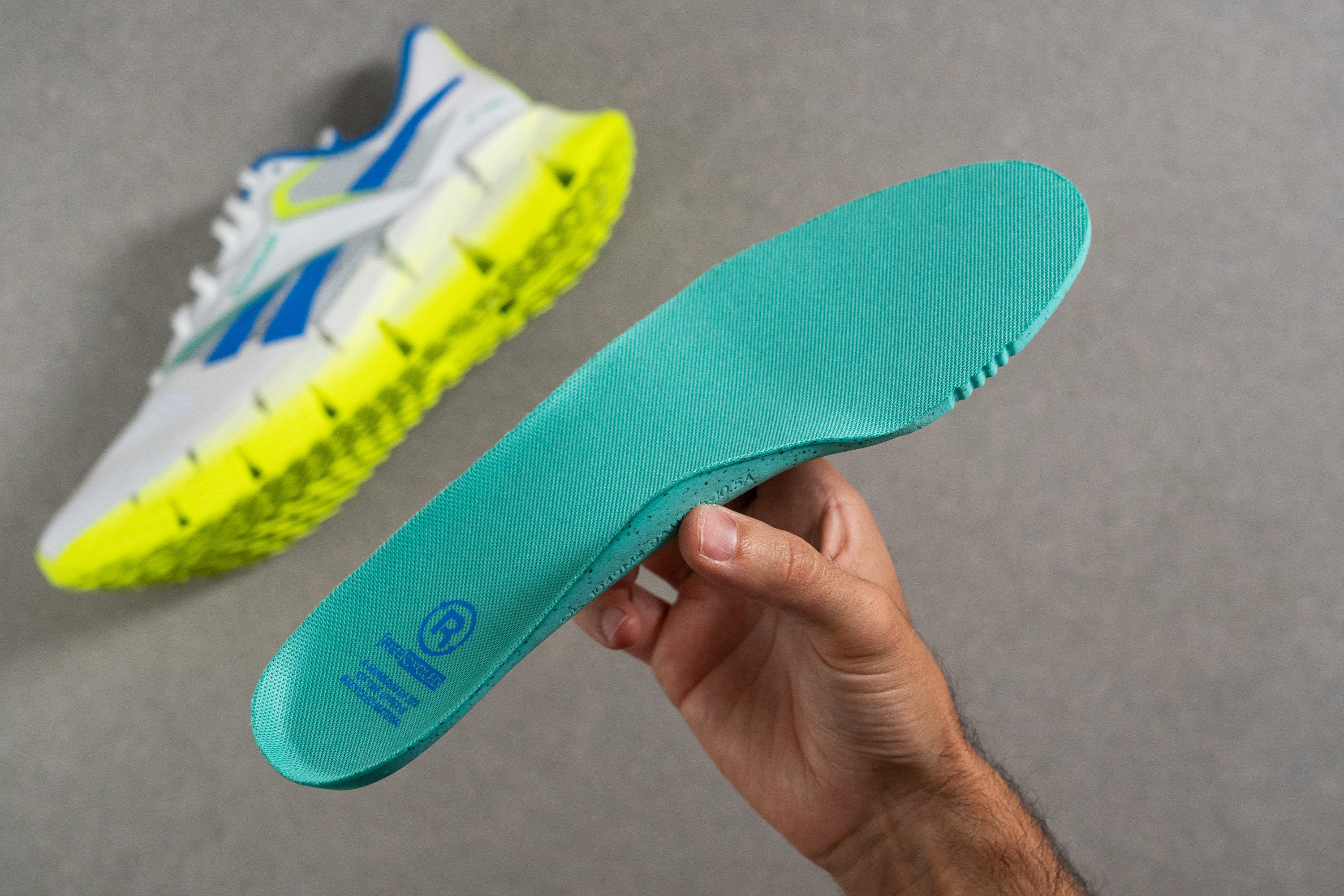
| FloatZig 1 | Yes |
Midsole softness in cold (%)
Compared to standard EVA, TPE offers several advantages like enhanced energy return and improved resistance to cold. In our tests, the FloatZig 1 showed only a 26.2% variation after 20 minutes in the freezer, outperforming most EVA-based shoes.
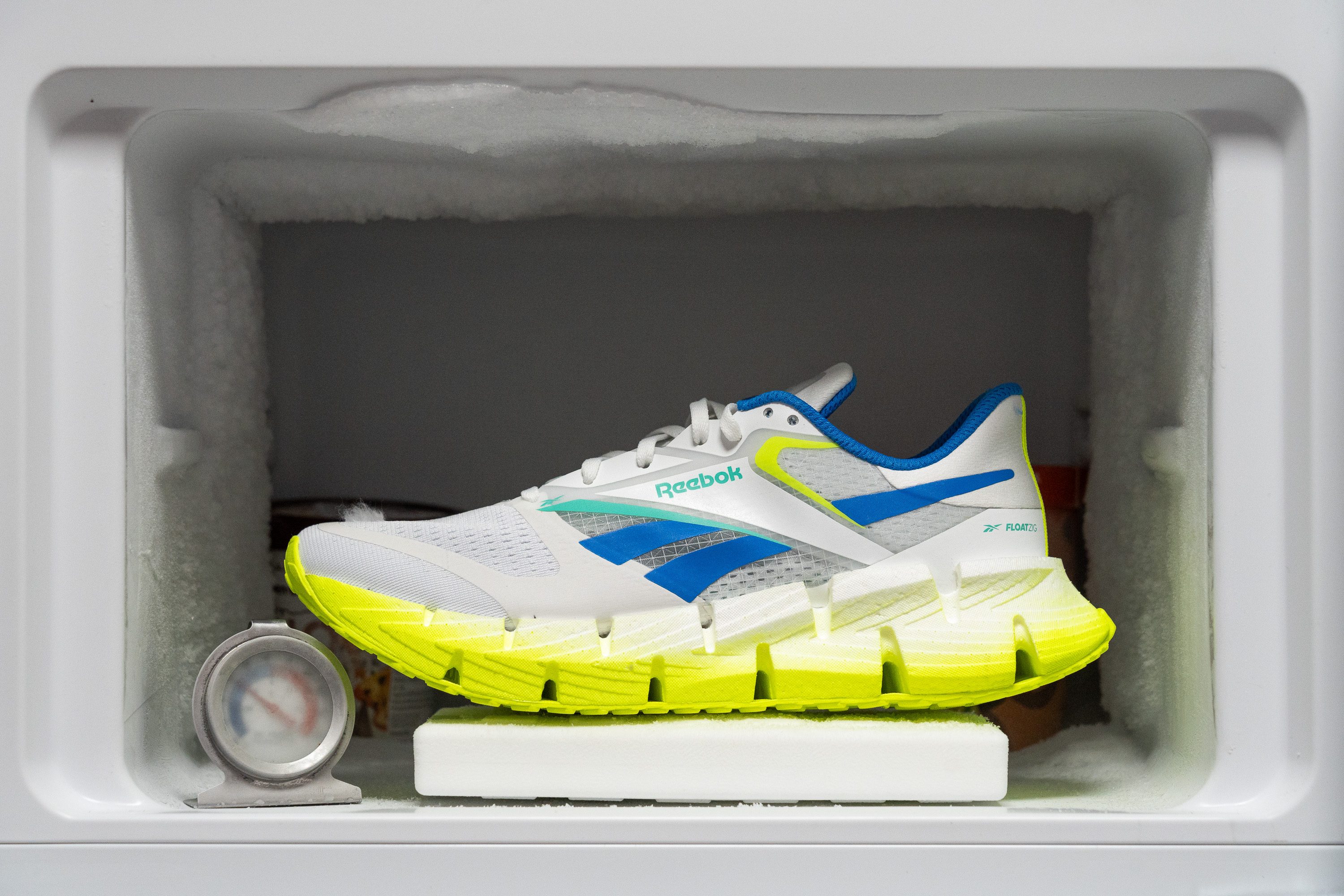
| FloatZig 1 | 26% |
| Average | 24% |
Reflective elements
Many brands cut corners by skipping reflective elements, but Reebok took the opposite approach—seeing it as a chance to shine.
That’s why we discovered the FloatZig 1 boasts stunning, 360-degree reflectivity that’s hard to miss. This feature makes this daily trainer a great choice for runners in low-light conditions.
| FloatZig 1 | Yes |
Tongue padding
One of the standout features we enjoyed in the FloatZig 1 is its lacing system. For a daily trainer, we look for something simple, durable, and effective—and this one delivers with a secure, hassle-free design.

We also appreciated the tongue, which strikes a perfect balance between plush comfort and lightweight build at 8.1 mm of thickness. It’s soft and cushy without adding bulk—a design mistake we've seen in other shoes, like the over-padded Brooks Glycerin Max.

| FloatZig 1 | 8.1 mm |
| Average | 5.8 mm |
Tongue: gusset type
Affordable daily trainers often lack a tongue attached to the sides, but that’s not the case with the FloatZig 1. We were thrilled to discover a semi-gusseted design, offering a secure fit.

| FloatZig 1 | Both sides (semi) |
Price
The FloatZig 1 offers solid value compared to the usual daily trainers—it's even priced below some of the category’s top sellers!
It’s also a great choice if you’re looking to stand out with a shoe not seen on every runner, as Reebok remains a niche name in running for now. That said, they’re clearly aiming for a comeback reminiscent of their 90s success!
| FloatZig 1 | $130 |
| Average | $152 |
Heel tab
Heel tabs weren’t popular back in the day, and the FloatZig 1 from Reebok channels such strong retro vibes that it’s easy to see why they went with this classic heel design.
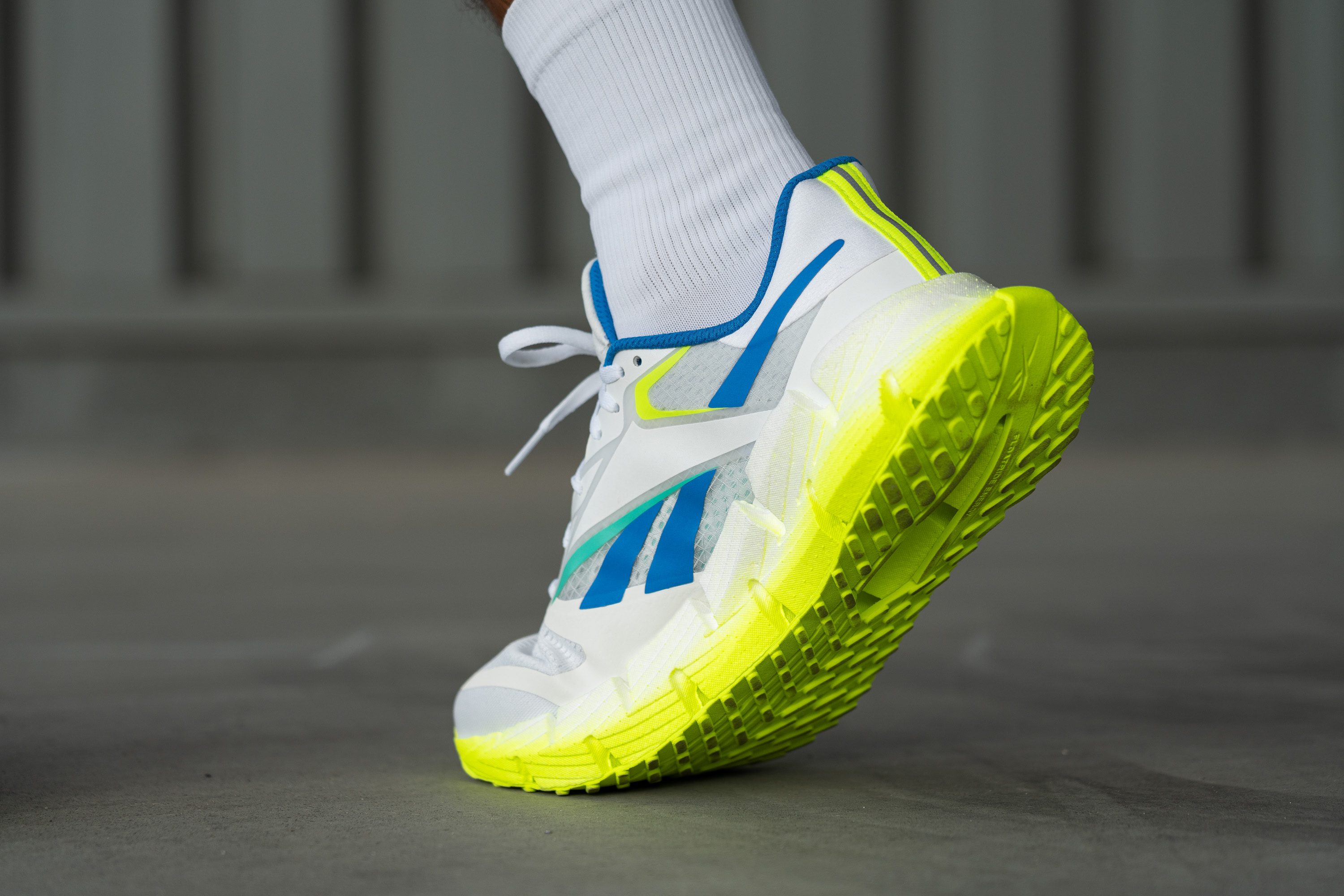
| FloatZig 1 | None |

